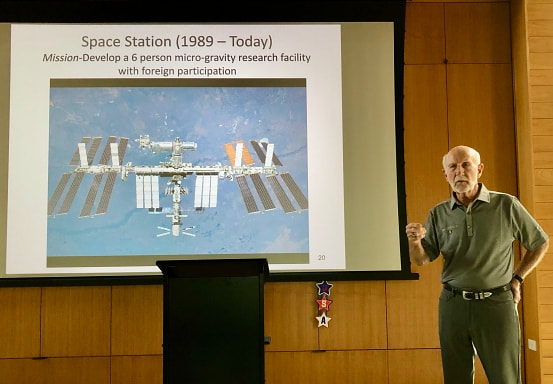Photo by Vicki L. George
May 24, 2021
NASA in Medina
By Vicki L. George
The Bandera Prophet
The Medina Community Library hosted Kerr County Commissioner Tom Moser on May 10. He gave a presentation on “Humans in Space — Past, Present and Future.”
Moser would know about space and people. While he is currently a county commissioner, he was formerly involved with the NASA Manned Spacecraft Center, now known as the Johnson Space Center, in Houston. As a mechanical design engineer he served during the Mercury, Gemini and early Apollo Programs.
Early in the Apollo Program he became engineering manager for the structures and materials for the Apollo Command Module and Launch Escape System. The LES was the system used to separate the Module from the rocket in case of a failure during the launch phase. Moser was also part of the team that designed and tested the Apollo docking system.
Before the first manned moon landing, Apollo 11, Moser worked with a few technicians to design, test and produce the US flag assembly to be planted on the moon.
After Apollo, which ended in 1983, Moser was a senior manager of the Space Shuttle program, from “sketch pad to launch pad.” He moved up through Director of Engineering, then Deputy Associate Administrator for Spaceflight at NASA Headquarters, and, in 1989, he became the first NASA Space Station Program Director.
After retiring from NASA, Moser was a senior executive in several aerospace companies and the executive director of the Texas Aerospace Commission.
Today Moser lives with his wife Ginnie on their ranch near Kerrville.
During his presentation on Humans in Space — Past, Present and Future, Moser began at the beginning with Former President John Kennedy, who prompted the United States to a race to the moon and beyond.
“In 1961, we had a commitment,” Moser said.“We didn’t know we couldn’t do it, so we did it.”
The whole purpose of the Apollo mission was to see if it could be done and there were many who wanted to plant a U.S. flag on the moon.
The next project was Skylab, started in 1973, and they realized they would need to be able to dock with the lab. So, in 1975, they came up with the international docking station.
The shuttle became the vehicle to get us up to the station. During that program, from 1981 to 2011, the shuttle flew 135 missions. Unfortunately, we lost two shuttles, the Orbiter and the Challenger.
We have focused on the space station since 1989. It is a lab without gravity.
Moser thinks private sector space flight will happen and welcomes it. He showed a slide depicting our plans to develop the moon. He said there is some water there and water contains hydrogen. The hydrogen can be mined and used for fuel, making the moon a refueling station to travel to Mars and beyond. It would also enable us to put up solar cells 2,000 miles above the earth to be used as power stations.
While Moser sees many benefits for us in these plans, he still asks, “Should we continue the journey?”
This special presentation was brought to Bandera County by the Faith and Freedom program. The next presentation is a Flag Day Celebration to be held Saturday, June 12, with a play about the 1978 Medina Flood, to which the public in invited.
Faith and Freedom programs celebrate America. For more information, call 830-955-0960.
Moser would know about space and people. While he is currently a county commissioner, he was formerly involved with the NASA Manned Spacecraft Center, now known as the Johnson Space Center, in Houston. As a mechanical design engineer he served during the Mercury, Gemini and early Apollo Programs.
Early in the Apollo Program he became engineering manager for the structures and materials for the Apollo Command Module and Launch Escape System. The LES was the system used to separate the Module from the rocket in case of a failure during the launch phase. Moser was also part of the team that designed and tested the Apollo docking system.
Before the first manned moon landing, Apollo 11, Moser worked with a few technicians to design, test and produce the US flag assembly to be planted on the moon.
After Apollo, which ended in 1983, Moser was a senior manager of the Space Shuttle program, from “sketch pad to launch pad.” He moved up through Director of Engineering, then Deputy Associate Administrator for Spaceflight at NASA Headquarters, and, in 1989, he became the first NASA Space Station Program Director.
After retiring from NASA, Moser was a senior executive in several aerospace companies and the executive director of the Texas Aerospace Commission.
Today Moser lives with his wife Ginnie on their ranch near Kerrville.
During his presentation on Humans in Space — Past, Present and Future, Moser began at the beginning with Former President John Kennedy, who prompted the United States to a race to the moon and beyond.
“In 1961, we had a commitment,” Moser said.“We didn’t know we couldn’t do it, so we did it.”
The whole purpose of the Apollo mission was to see if it could be done and there were many who wanted to plant a U.S. flag on the moon.
The next project was Skylab, started in 1973, and they realized they would need to be able to dock with the lab. So, in 1975, they came up with the international docking station.
The shuttle became the vehicle to get us up to the station. During that program, from 1981 to 2011, the shuttle flew 135 missions. Unfortunately, we lost two shuttles, the Orbiter and the Challenger.
We have focused on the space station since 1989. It is a lab without gravity.
Moser thinks private sector space flight will happen and welcomes it. He showed a slide depicting our plans to develop the moon. He said there is some water there and water contains hydrogen. The hydrogen can be mined and used for fuel, making the moon a refueling station to travel to Mars and beyond. It would also enable us to put up solar cells 2,000 miles above the earth to be used as power stations.
While Moser sees many benefits for us in these plans, he still asks, “Should we continue the journey?”
This special presentation was brought to Bandera County by the Faith and Freedom program. The next presentation is a Flag Day Celebration to be held Saturday, June 12, with a play about the 1978 Medina Flood, to which the public in invited.
Faith and Freedom programs celebrate America. For more information, call 830-955-0960.


